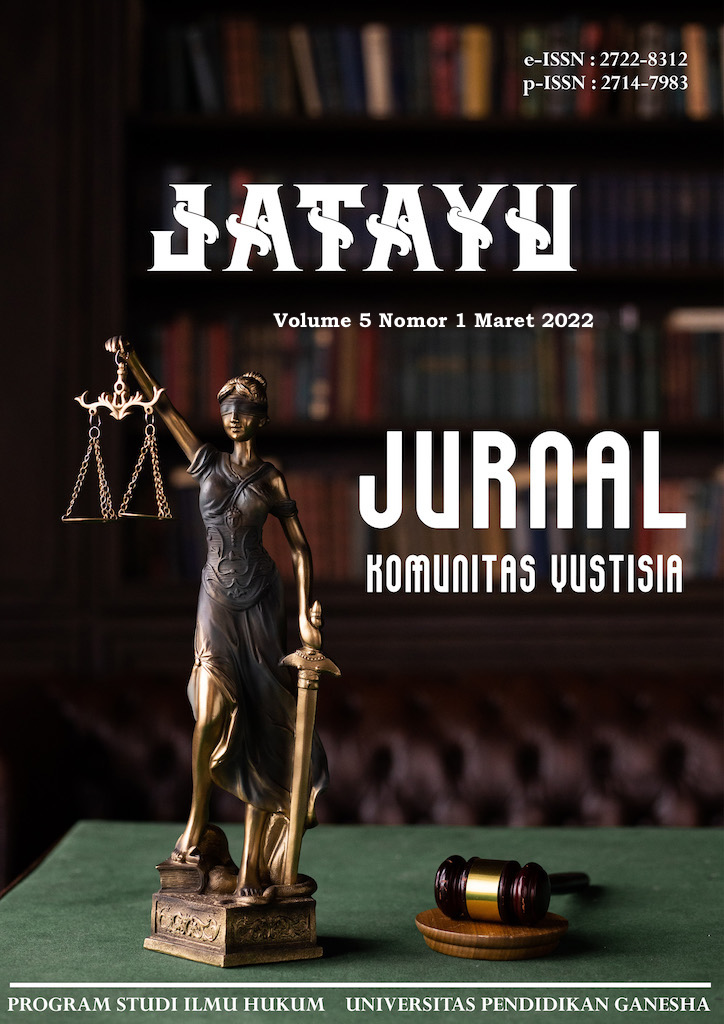PERLINDUNGAN HUKUM INTERNASIONAL TERHADAP PENGGUNAAN TENTARA ANAK DALAM KONFLIK BERSENJATA PERSPEKTIF KONVENSI ILO (INTERNATIONAL LABOUR ORGANIZATION) NO. 182 TAHUN 1999
DOI:
https://doi.org/10.23887/jatayu.v5i2.51629Keywords:
Tentara Anak, Konflik Bersenjata, Kovensi ILO.Abstract
Penelitian ini bertujuan untuk mengetahui pengaturan hukum yang mengatur mengenai tentara anak dalam konflik bersenjata dalam perspektif Konvensi ILO (International Labour Organization) No. 182 Tahun 1999 dan untuk mengetahui perlindungan hukum serta status bagi anak anak yang direkrut sebagai tentara anak. Metode penelitian yang digunakan dalam tulisan ini adalah metode penelitian hukum normatif. Dalam penelitian ini pendekatan yang digunakan adalah pendekatan perundang-undangan (Statute Approach), pendekatan konseptual (Conseptual Approah), dan pendekatan kasus (Case Approach). Sumber bahan hukum yang digunakan dalam penelitian ini adalah bahan hukum primer, bahan hukum sekunder dan bahan hukum tersier serta Analisis bahan hukum dilakukan secara deskriptif. Hasil penelitian ini menunjukkan bahwa pengaturan hukum yang mengatur mengenai penggunaan tentara anak dalam konflik bersenjata dalam perspektif Konvensi ILO No. 182 tahun 1999 secara khusus konvensi ini mengatur dan melindungi anak-anak dari segala bentuk pekerjaan terburuk dalam Hukum Internasional terdapat beberapa regulasi hukum yang mengatur tentang hak anak dan tentara anak yaitu Konvensi Jenewa 1949, Protokol Tambahan tahun 1977, Konvensi Hak Anak dan Protokol Tambahannya. Perlindungan hukum bagi anak-anak yang direkrut sebagai tentara anak yaitu yang pertama adalah perlindungan berdasarkan Prinsip Pembeda, perlindungan berdasarkan pasal-pasal dalam Konvensi Jenewa, Protokol Tambahan Konvensi Jenewa Tahun 1977, Konvensi Hak Anak dan Protokol Tambahannya. Selain itu ada beberapa. Instrumen hukum lainnya yang juga mengatur menganai perlindungan terhadap hak-hak anak. yang juga mengatur menganai perlindungan terhadap hak-hak anak.
Downloads
Published
Versions
- 2022-10-24 (4)
- 2022-10-24 (3)
- 2022-10-24 (2)
- 2022-08-26 (1)
Issue
Section
License

This work is licensed under a Creative Commons Attribution-ShareAlike 4.0 International License.
Authors who publish with this journal agree to the following terms: Authors retain copyright and grant the journal right of first publication with the work simultaneously licensed under a Creative Commons Attribution License that allows others to share the work with an acknowledgement of the work's authorship and initial publication in this journal. Authors are able to enter into separate, additional contractual arrangements for the non-exclusive distribution of the journal's published version of the work (e.g., post it to an institutional repository or publish it in a book), with an acknowledgement of its initial publication in this journal. Authors are permitted and encouraged to post their work online (e.g., in institutional repositories or on their website) prior to and during the submission process, as it can lead to productive exchanges, as well as earlier and greater citation of published work (See The Effect of Open Access). Authors who publish with this journal agree to the following terms: Authors retain copyright and grant the journal right of first publication, with the work [SPECIFY PERIOD OF TIME] after publication simultaneously licensed under aCreative Commons Attribution License that allows others to share the work with an acknowledgement of the work's authorship and initial publication in this journal. Authors are able to enter into separate, additional contractual arrangements for the non-exclusive distribution of the journal's published version of the work (e.g., post it to an institutional repository or publish it in a book), with an acknowledgement of its initial publication in this journal. Authors are permitted and encouraged to post their work online (e.g., in institutional repositories or on their website) prior to and during the submission process, as it can lead to productive exchanges, as well as earlier and greater citation of published work (See The Effect of Open Access).






